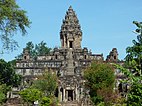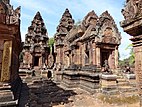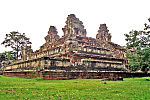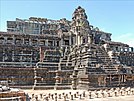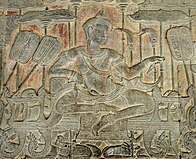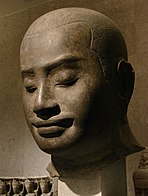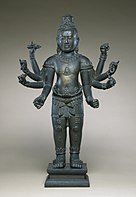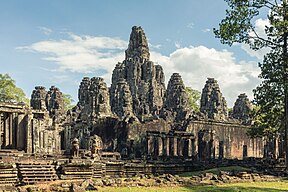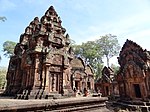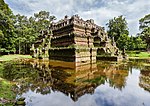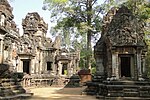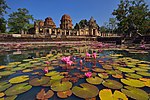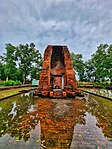Khmer Empire
Kambuja កម្ពុជ ( | |||||||||||||
|---|---|---|---|---|---|---|---|---|---|---|---|---|---|
| 802–1431 | |||||||||||||
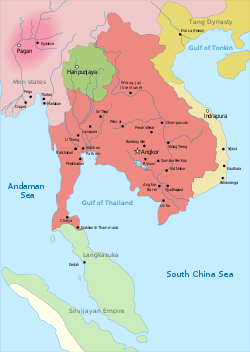 The Khmer Empire (Kambuja), c. 900 | |||||||||||||
| Capital |
| ||||||||||||
King | |||||||||||||
• 802–850 | Jayavarman II (first) | ||||||||||||
• 1417–1431 | Borom Reachea II (last) | ||||||||||||
| Historical era | Post-classical | ||||||||||||
| 802 | |||||||||||||
• Construction of Angkor Wat | 1113–1150 | ||||||||||||
| 1431 | |||||||||||||
| Area | |||||||||||||
| 1290[1][2] | 1,000,000 km2 (390,000 sq mi) | ||||||||||||
| |||||||||||||
| History of Cambodia |
|---|
| Early history |
|
Post-Angkor Period |
| Colonial period |
| Independence and conflict |
| Peace process |
| Modern Cambodia |
| By topic |
|
|
The Khmer Empire was a
The beginning of the Khmer Empire is conventionally dated to 802, when
The site of Angkor is perhaps the empire's most notable legacy, as it was the capital during the empire's zenith. The majestic monuments of Angkor, such as Angkor Wat and the Bayon, bear testimony to the Khmer Empire's immense power and wealth, impressive art and culture, architectural technique, aesthetic achievements, and variety of belief systems that it patronised over time. Satellite imaging has revealed that Angkor, during its peak in the 11th to the 13th centuries, was the most extensive pre-industrial urban complex in the world.[9][10] Researchers have also concluded that the Khmer Empire invented the world's first healthcare system, which included 102 hospitals.[11]
Etymology
Modern scholars often refer to the empire as the "Khmer Empire" (Khmer: ចក្រភពខ្មែរ) or the "Angkor Empire" (Khmer: ចក្រភពអង្គរ), the latter after the capital Angkor.
The empire referred to itself as Kambuja (
Historiography
No written records of the Angkor period have survived other than stone inscriptions. Current knowledge of the historical Khmer civilisation is derived primarily from:
- Archaeological excavation, reconstruction and investigation
- Stone inscriptions (the most important of which are foundation steles of temples), which report on the political and religious deeds of the kings
- Reliefs in a series of temple walls with depictions of daily life, market scenes, military marches, and palace life
- Reports and chronicles of Chinese diplomats, traders, and travellers
History
Formation and growth
Reign of Jayavarman II

According to an inscription in the Sdok Kok Thom temple,[12]: 97 [13]: 353–354 around 781 the Khmer prince Jayavarman II established Indrapura as the capital of his domain. It was located in Banteay Prey Nokor, near today's Kampong Cham.[14] After returning to his home in the former kingdom of Chenla, he quickly built up his influence and defeated a series of competing kings. In 790 he became king of a kingdom called Kambuja by the Khmer. He then moved his court northwest to Mahendraparvata, far inland north from the great lake of Tonlé Sap.
Jayavarman II (reigned 802–835)
Historians debate whether "Java" means the
Jayavarman's political career began in
In the following years, Jayavarman II extended his territory and established a new capital, Hariharalaya, near the modern-day town of Roluos.[12]: 98 He thereby laid the foundation of Angkor, which was to arise some 15 kilometres (9.3 mi) to the northwest. Jayavarman II died in 835[15]: 59 and was succeeded by his son Jayavarman III.[12]: 103 [22] Jayavarman III died in 877 and was succeeded by Indravarman I.[12]: 110
The successors of Jayavarman II kept extending the territory of Kambuja. Indravarman I (reigned 877–889) managed to expand the kingdom without wars and initiated extensive building projects, which were enabled by the wealth gained through trade and agriculture. Foremost were the temple of Preah Ko and irrigation works. Indravarman I developed Hariharalaya further by constructing Bakong[13]: 354–358 circa 881.[12]: 110–111 Bakong in particular bears striking similarities to the Borobudur temple in Java, which suggests that it may have served as the prototype for Bakong. There were at the time exchanges of travellers and missions between Kambuja and the Sailendras in Java, which brought to Cambodia not only ideas, but also technical and architectural details.[23][24]
Establishment of Yasodharapura
Indravarman I was followed by his son
At the beginning of the 10th century, the empire fractured. Jayavarman IV moved the capital to Lingapura (now known as Koh Ker), some 100 kilometres (62 mi) northeast of Angkor.[13]: 360, 363 Only when Rajendravarman II ascended to the throne (reigned 944–968) was the royal palace returned to Yasodharapura. He once again took up the extensive building schemes of the earlier kings and established a series of Hindu temples in the Angkor area, such as Pre Rup and the East Mebon, a temple located on an artificial island in the center of the East Baray. Several Buddhist temples and monasteries were also built.[13]: 363–367 In 950, the first war took place between Kambuja and the kingdom of Champa to the east (in what is now central Vietnam).[12]: 114–117
The son of Rajendravarman II, Jayavarman V, reigned from 968 to 1001, after establishing himself as the new king over the other princes. His rule was a largely peaceful period, marked by prosperity and a cultural flowering. He established a new capital slightly west of his father's and named it Jayendranagari; its state temple, Ta Keo, was to the south. At the court of Jayavarman V lived philosophers, scholars, and artists. New temples were also established; the most important of these were Banteay Srei, considered one of the most beautiful and artistic of Angkor, and Ta Keo, the first temple of Angkor built completely of sandstone.[12]: 117–118 [13]: 367

A decade of conflict followed the death of Jayavarman V. Three kings reigned simultaneously as antagonists to each other until Suryavarman I (reigned 1006–1050) ascended to the throne by taking the capital Angkor.[12]: 134–135 His rule was marked by repeated attempts by his opponents to overthrow him and military conflicts with neighbouring kingdoms.[25] Suryavarman I established diplomatic relations with the Chola dynasty of south India early in his rule.[26]
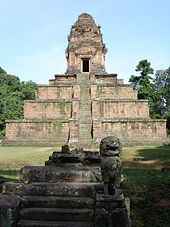
In the first decade of the 11th century, Kambuja came into conflict with the kingdom of
Suryavarman I's wife was Viralakshmi, and following his death in 1050, he was succeeded by Udayadityavarman II, who built the Baphuon and West Baray.[12]: 135, 137–138 In 1074, conflict arose between Harshavarman III, the younger brother and successor of Udayadityavarman II, and the Champa king Harivarman IV.[12]: 152
Golden age of Khmer civilisation
Reign of Suryavarman II and Angkor Wat
The 12th century was a time of conflict and brutal power struggles. Under
Another period followed in which kings reigned briefly and were violently overthrown by their successors. Finally, in 1177 the capital was raided and looted in a
: 78Reign of Jayavarman VII and Angkor Thom
King
Jayavarman VII stands as the last of the great kings of Angkor, not only because of his successful military campaign against Champa, but also because he was not a tyrannical ruler in the manner of his immediate predecessors.[
Reign of Jayavarman VIII
After the death of Jayavarman VII, his son Indravarman II (reigned 1219–1243) ascended to the throne.[12]: 180–181 Like his father, he was a Buddhist, and he completed a series of temples begun under his father's rule. As a warrior he was less successful. In 1220, under mounting pressure from the increasingly powerful Dai Viet and its ally Champa, the Khmer withdrew from many of the provinces previously conquered from the Chams.
Indravarman II was succeeded by
In August 1296, the Chinese diplomat Zhou Daguan arrived in Angkor and recorded, "In the recent war with the Siamese, the country was utterly devastated".[12]: 211 [32]: 90 He remained at the court of Srindravarman until July 1297. He was neither the first nor the last Chinese representative to visit Kambuja. His stay is notable, however, because Zhou later wrote a detailed report on life in Angkor. His portrayal of the empire is today one of the most important sources of understanding historical Angkor. Alongside the descriptions within several great temples (the Bayon, the Baphuon, Angkor Wat), his account informs us that the towers of the Bayon were once covered in gold; the text also offers valuable information on the everyday life and habits of the inhabitants of Angkor.
Decline
By the 14th century, Kambuja had suffered a long, arduous, and steady decline. Historians have proposed different causes for the decline: the religious conversion from Vishnuite-Shivaite Hinduism to Theravada Buddhism that affected social and political systems, incessant internal power struggles among Khmer princes, vassal revolt, foreign invasion, plague, and ecological breakdown.
For social and religious reasons, many aspects contributed to the decline of Kambuja. The relationship between the rulers and their elites was unstable – among the 27 rulers of Kambuja, eleven lacked a legitimate claim to power, and violent power struggles were frequent. Kambuja focused more on its domestic economy and did not take advantage of the international maritime trade network. The input of Buddhist ideas also conflicted with and disturbed the state order built under Hinduism.[37]
Conversion from Hinduism to Buddhism
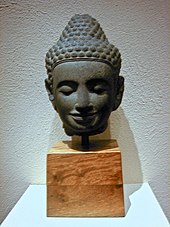
The last Sanskrit inscription is dated 1327 and describes the succession of Indrajayavarman by Jayavarmadiparamesvara.[12]: 228 Historians suspect a connection with the kings' adoption of Theravada Buddhism: the kings were no longer considered devarajas (god kings) and there was therefore no need to erect huge temples to them, or rather to the gods under whose protection they stood.[citation needed] The retreat from the concept of the devaraja may also have led to a loss of royal authority and thereby to a lack of workers.[speculation?] The water-management apparatus also degenerated, meaning that harvests were reduced by floods or drought. While previously three rice harvests per year were possible – a substantial contribution to the prosperity and power of Kambuja – the declining harvests further weakened the empire.
Looking at the archaeological record, however, archaeologists noticed that not only were the structures ceasing to be built, but the Khmer's historical inscription was also lacking from the 14th to 17th centuries. With this lack of historical content, there is very limited archaeological evidence to work with. However, archaeologists have been able to determine that the sites were abandoned and then reoccupied later by different people.[38]
Foreign pressure
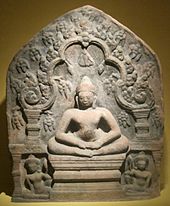
The Ayutthaya Kingdom arose from a confederation of three city-states on the Lower Chao Phraya basin (Ayutthaya-Suphanburi-Lopburi).[39] From the fourteenth century onward, Ayutthaya became Kambuja's rival.[12]: 222–223 Angkor was besieged by the Ayutthayan king Uthong in 1352, and following its capture the next year, the Khmer king was replaced with successive Siamese princes. Then in 1357, the Khmer king Suryavamsa Rajadhiraja retook the throne.[12]: 236 In 1393, the Ayutthayan king Ramesuan besieged Angkor again, capturing it the next year. Ramesuan's son ruled Kambuja for a short time before being assassinated. Finally, in 1431, the Khmer king Ponhea Yat abandoned Angkor as indefensible, and moved to the Phnom Penh area.[12]: 236–237
The new centre of the Khmer kingdom was in the southwest, at Oudong near present-day Phnom Penh. However, there are indications that Angkor was not completely abandoned. One line of Khmer kings may have remained there, while a second moved to Phnom Penh to establish a parallel kingdom. The final fall of Angkor would then be due to the transfer of economic – and therewith political – significance, as Phnom Penh became an important trade centre on the Mekong. Severe droughts and ensuing floods were considered one of the contributing factors to its fall.[40] The empire focused more on regional trade after the first drought.[41]
Ecological breakdown
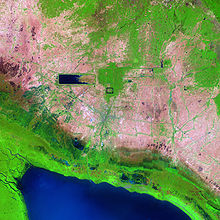
Ecological failure and infrastructural breakdown is an alternative theory regarding the end of Kambuja. Scientists working on the Greater Angkor Project believe that the Khmers had an elaborate system of reservoirs and canals used for trade, transportation, and irrigation. The canals were used for harvesting rice. As the population grew there was more strain on the water system. During the fourteenth and fifteenth centuries, there were also severe climatic changes impacting the water management system.[40]
Periods of drought led to decreases in agricultural productivity, and violent floods due to monsoons damaged the infrastructure during this vulnerable time.[40] To adapt to the growing population, trees were cut down from the Kulen hills and cleared out for more rice fields. That created rain runoff carrying sediment to the canal network. Any damage to the water system would have enormous consequences.[42]
Plague
The plague theory, which suggests a severe epidemic outbreak may have hit the heavily populated Angkor and contributed to the fall of the empire, has been reconsidered.[43] By the 14th century, the Black Death had affected Asia, as the plague first appeared in China around 1330 and reached Europe around 1345. Most seaports along the line of travel from China to Europe felt the impact of the disease, which might have had a severe impact on life throughout Southeast Asia. Possible diseases include bubonic plague, smallpox and malaria.
Angkor after the 15th century
There is evidence for a further period of use of Angkor after the 15th century. Under the rule of Khmer king
Culture and society

Much of what is known about Kambuja comes from the bas-reliefs of Angkor's temples and the first-hand accounts of Chinese diplomat Zhou Daguan (The Customs of Cambodia), which provide information on 13th-century Cambodia and earlier. The bas-reliefs, such as those in the Bayon, describe everyday life in the ancient Khmer kingdom, including scenes of palace life, naval battles on the river and lakes, and common scenes of the marketplace.
Economy and agriculture
The ancient Khmers were a traditional agricultural community, relying heavily on
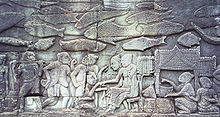
Located by the massive Tonlé Sap lake, and also near numerous rivers and ponds, many Khmer people relied on fresh water fisheries for their living. Fishing gave the population their main source of protein, which was turned into prahok – dried or roasted or steamed fish paste wrapped in banana leaves. Rice was the main staple along with fish. Other sources of protein included pigs, cattle, and poultry, which were kept under the farmers' houses, which were elevated on stilts to protect them from flooding.
The marketplace of Angkor contained no permanent buildings; it was an open square where the traders sat on the ground on woven straw mats and sold their wares. There were no tables or chairs. Some traders might be protected from the sun with a simple thatched parasol. A certain type of tax or rent was levied by officials for each space occupied by traders in the marketplace. The trade and economy in the Angkor marketplace were mainly run by women.
Zhou Daguan's description of the women of Angkor:[46][47]
The local people who know how to trade are all women. So when a Chinese man goes to this country, the first thing he must do is take in a woman, partly with a view of profiting from her trading abilities.
The women age very quickly, no doubt because they marry and give birth when they are too young. When they are twenty or thirty-years-old, they look like Chinese women who are forty or fifty.
The role of women in the trade and economy of Kambuja suggests that they enjoyed significant rights and freedom.[specify] Their practice of marrying early may have contributed to the high fertility rate and huge population of the kingdom.[46]
Society and politics

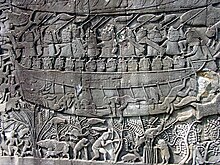
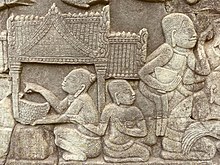
Kambuja was founded upon extensive networks of agricultural
Society was arranged in a hierarchy reflecting the
The extensive irrigation projects provided rice surpluses that could support a large population. The state religion was Hinduism but influenced by the cult of Devaraja, elevating the Khmer kings as possessing the divine quality of living gods on earth, attributed to the incarnation of Vishnu or Shiva.[49] In politics, this status was viewed as the divine justification of a king's rule. The cult enabled the Khmer kings to embark on massive architectural projects, constructing majestic monuments such as Angkor Wat and the Bayon to celebrate the king's divine rule on earth.
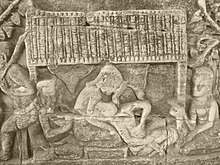
The King was surrounded by ministers, state officials, nobles, royalties, palace women, and servants, all protected by guards and troops. The capital city of Angkor and the Khmer royal court are famous for grand ceremonies, with many festivals and rituals held in the city. Even when travelling, the King and his entourages created quite a spectacle, as described in Zhou Daguan's accounts. Zhou Daguan's description of a royal procession of Indravarman III is as follows:[50]
When the king goes out, troops are at the head of [his] escort; then come flags, banners and music. Palace women, numbering from three to five hundred, wearing flowered cloth, with flowers in their hair, hold candles in their hands, and form a troupe. Even in broad daylight, the candles are lighted. Then come other palace women, bearing royal paraphernalia made of gold and silver... Then come the palace women carrying lances and shields, with the king's private guards. Carts drawn by goats and horses, all in gold, come next. Ministers and princes are mounted on elephants, and in front of them one can see, from afar, their innumerable red umbrellas. After them come the wives and concubines of the king, in palanquins, carriages, on horseback and on elephants. They have more than one hundred parasols, flecked with gold. Behind them comes the sovereign, standing on an elephant, holding his sacred sword in his hand. The elephant's tusks are encased in gold.
Zhou Daguan's description of the Khmer king's wardrobe:[47]
Only the ruler can dress in cloth with an all-over floral design...Around his neck he wears about three pounds of big pearls. At his wrists, ankles and fingers he has gold bracelets and rings all set with cat's eyes...When he goes out, he holds a golden sword [of state] in his hand.
Khmer kings were often involved in series of wars and conquests. The large population of Angkor enabled the kingdom to support large free standing armies, which were sometimes deployed to conquer neighbouring princedoms or kingdoms. Series of conquests were led to expand the kingdom's influence over areas surrounding Angkor and Tonle Sap, the Mekong valley and delta, and surrounding lands. Some Khmer kings embarked on military conquests and war against neighbouring
Military
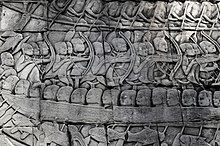
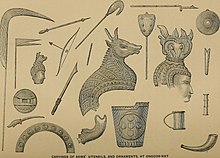
According to Zhou Daguan, who stayed in Yaśodharapura from 1296 to 1297, the Sukhothai Kingdom laid waste to Khmer lands in repeated wars. According to Zhou, the Khmer soldiers fought naked and barefoot, wielding only lance and shield. They did not use bows and arrows (though, in some instances, they used them in naval warfare), trebuchets, body armour, or helmets. When Sukhotai attacked, ordinary people were ordered to face them without strategy or preparation.[51] The Khmer had double bow crossbows mounted on elephants, which Michel JacqHergoualc'h suggests were elements of Cham mercenaries in Jayavarman VII's army.[52]
In terms of fortifications, Zhou described Angkor Thom's walls as being 10 kilometres (6.2 mi) long in circumference with five gateways, each with two gates, surrounded by a large moat spanned by bridges. The walls, which formed an exact square, were made of stone and so tightly packed that no weeds grew from them. The walls were around 6–7 meters in height and sloped from the inside, thick enough to contain chambers, but with no battlements and only a single stone tower on each of the four sides. Guards operated them, but dogs were not allowed on the walls.[53] According to an oral tradition told to Henri Mouhot, Kambuja had a standing army of 5 to 6 million soldiers.[54]
Culture and way of life

Zhou Daguan's description of Khmer houses:[47]
The dwellings of the princes and principal officials have a completely different layout and dimensions from those of the people. All the outlying buildings are covered with thatch; only the family temple and the principal apartment can be covered in tiles. The official rank of each person determines the size of the houses.
Houses of farmers were situated near the rice paddies on the edge of the cities. The walls of the houses were made of woven bamboo, with thatched roofs, and they were on stilts. A house was divided into three rooms by woven bamboo walls. One was the parents' bedroom, another was the daughters' bedroom, and the largest was the living area. Sons slept wherever they could find space. The kitchen was at the back or in a separate room. Nobles and kings lived in the palace and much larger houses in the city. They were made of the same materials as the farmers' houses, but the roofs were wooden shingles and had elaborate designs as well as more rooms.
Zhou Daguan reported that locals do not produce silk or have the ability to stitch and darn with a needle and thread.[55]
None of the locals produces silk. Nor do the women know how to stitch and darn with a needle and thread. The only thing they can do is weave cotton from kapok. Even then they cannot spin the yarn, but just use their hands to gather the cloth into strands. They do not use a loom for weaving. Instead they just wind one end of the cloth around their waist, hang the other end over a window, and use a bamboo tube as a shuttle. In recent years people from Siam have come to live in Cambodia, and unlike the locals they engage in silk production. The mulberry trees they grow and the silkworms they raise all come from Siam. They themselves weave the silk into clothes made of a black, patterned satiny silk. Siamese women do know how to stitch and darn, so when local people have torn or damaged clothing they ask them to do the mending.
The common people wore a
Religion
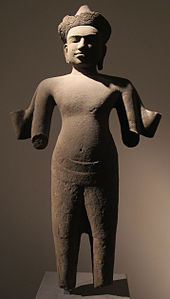
The main religion was Hinduism, followed by Buddhism in popularity.[citation needed] Initially, the kingdom revered Hinduism as the main state religion.[citation needed] Vishnu and Shiva were the most revered deities, worshipped in Khmer Hindu temples. Temples such as Angkor Wat are actually known as Phitsanulok (Vara Vishnuloka in Sanskrit) or the realm of Vishnu, to honour the posthumous King Suryavarman II as Vishnu.
Hindu ceremonies and rituals performed by Brahmins (Hindu priests), usually only held among the ruling elites of the king's family, nobles, and the ruling class. The empire's official religions included Hinduism and
Art and architecture
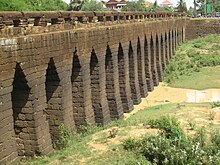
Zhou Daguan's description on the Angkor Royal Palace:[57]
All official buildings and homes of the aristocracy, including the Royal Palace, face the east. The Royal Palace stands north of the Golden Tower and the Bridge of Gold: it is one and a half mile in circumference. The tiles of the main dwelling are of lead. Other dwellings are covered with yellow-coloured pottery tiles. Carved or painted Buddhas decorate all the immense columns and lintels. The roofs are impressive too. Open corridors and long colonnades, arranged in harmonious patterns, stretch away on all sides.
Kambuja produced numerous temples and majestic monuments to celebrate the divine authority of Khmer kings. Khmer architecture reflects the Hindu belief that the temple was built to recreate the abode of
Khmer art and architecture reached their aesthetic and technical peak with the construction of the majestic temple
List of architectural styles during Angkor period:[58]
| Styles | Dates | Rulers | Temples | Chief Characteristics |
|---|---|---|---|---|
| Kulen | 825–875 | Jayavarman II | Damrei Krap | Continuation of pre-Angkorean but a period of innovation and borrowing such as from Cham temples. Tower mainly square and relatively high. Mainly brick with laterite walls and stone door surrounds. Square and octagonal colonettes begin to appear.
|
| Preah Ko | 877–886 | Indravarman I Jayavarman III | Preah Ko, Bakong, Lolei | Simple plan: one or more square brick towers on a single base. First appearance of concentric enclosures and of temple mountain at Bakong .
|
Bakheng |
889–923 | Yasovarman I Harshavarman I | Phnom Bakheng, Phnom Krom, Phnom Bok, Baksei Chamkrong (trans.) | Development of the temple mountain . More use of stone, particularly for major temples and more decorative stone carving.
|
| Koh Ker | 921–944 | Jayavarman IV | Group of Koh Ker temples | Scale of buildings diminishes toward center. Brick still main material but sandstone also used. |
| Pre Rup | 944–968 | Rajendravarman |
Pre Rup, East Mebon, Bat Chum, Kutisvara | Transitional between Koh Ker and Banteay Srei. Long halls partly enclose sanctuary. The last great monuments in plastered brick, increasing use of sandstone. |
| Banteay Srei | 967–1000 | Jayavarman V | Banteay Srei | Ornate, superposed pediments, sweeping gable ends, rich and deep carving. Plasterd brick replaced by stone and laterite. Appearance of scenes in pediments. Voluptuous devatas with gentle expressions. |
Khleang |
968–1010 | Jayavarman V | Khleangs, Phimeanakas , Royal Palace |
First use of galleries. Cruciform gopuras. Octagonal colonettes. Restrained decorative carving. |
| Baphuon | 1050–1080 | Udayadityavarman II | Baphuon, West Mebon | A return to rich carving: floral motifs but also Bas-reliefs appear at Baphuon temple, carving with lively scenes enclosed in small panels, often in narritive sequence.
|
| Angkor Wat | 1113–1175 | Suryavarman II Yasovarman II | Phnom Rung |
The high classical style of Khmer architecture. Fully developed conical towers with carving profile. Galleries wider and with half galleries on one side. Concentric enclosures connected by axial galleries. Nagas with head-dress, naga balustrades raised off the ground. Invention of cross-shaped terrace. Richly carved lintels and other decorations. Bas-reliefs, Apsaras. |
| Bayon | 1181–1243 | Jayavarman VII Indravarman II | Elephant terrace, Ta Prohm Kel, Krol Ko, Prasat Suor Prat, Banteay Chhmar, Hospital Chaples, Jayatataka baray |
The last great style. Hurried construction, often in laterite not stone, carving less elegant. Complex plans, huge temples. In Cambodia, face-towers and historical narrative bas-reliefs. Three periods: 1. large complex temples on a single level, 2. face-towers and avenues of giants carrying nagas, 3. decline of the building standards, devatas acquire Angkor Wat style diadem. |
| Post Bayon | 1243–15th c. | Jayavarman VIII and others | Terrace of the Leper King, Preah Pithu, Preah Palilay (modifications to temples) | Inversion of cross-shaped terrace, causeways on columns, low or high. |
Relations with regional powers
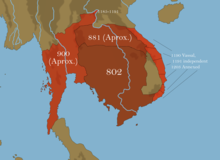
During the formation of the empire, the Khmer had close cultural, political, and trade relations with
Zabaj is the
In 916 CE Arab historian Abu Zaid Hasan, recorded in a lengthy chronicle that the young, inexperienced king of Khmer, is hostile to Java. When the hostility becomes state policy and is known publicly, the King of Java attacked and captured the Khmer king. He was beheaded and the head brought to Java. The King of Java ordered the Minister of Khmer Empire to seek the successor. After being cleaned and embalmed, the head of the king was put in a vase and sent to the new Khmer king.[62]
Throughout its history, the empire also was involved in series of wars and rivalries with the neighbouring kingdoms of
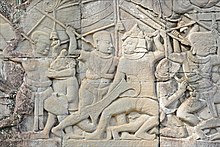
The Khmer Empire seems to have maintained contact with
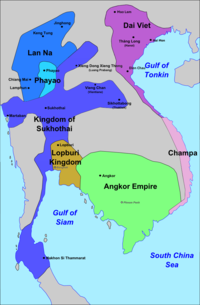
Beginning in the 13th century, Khmer's relations with the
In the 1300s, the Lao prince
A Javanese source, the
This record describes the political situations in Mainland Southeast Asia in the mid-14th century; although the Cambodian kingdom still survived, the rise of Siamese Ayutthaya had taken its toll. Finally, the empire fell, marked by the abandonment of Angkor for Phnom Penh in 1431, caused by Siamese pressure.List of rulers
| Reign | King | Capital | Information and events |
|---|---|---|---|
| 802–835 | Jayavarman II | Mahendraparvata, Hariharalaya | Proclaimed the independence of Kambuja from Chakravartin through sacred Hindu ritual on Phnom Kulen and initiating Devaraja cult in Cambodia.
|
| 835–877 | Jayavarman III | Hariharalaya | Son of Jayavarman II |
| 877–889 | Indravarman I | Hariharalaya | Nephew of Jayavarman II. Built Preah Ko dedicated to Jayavarman II, also for his father and his grand father. Constructed temple mountain Bakong. |
| 889–910 | Yasovarman I | Hariharalaya, Yaśodharapura | Son of Indravarman I. Built Indratataka Baray and Lolei. Moved the capital to Yaśodharapura centred around Phnom Bakheng, and also built Yashodharatataka. |
| 910–923 | Harshavarman I | Yaśodharapura | Son of Yasovarman I. Involved in a power struggle against his maternal uncle Jayavarman IV. Built Baksei Chamkrong. |
| 923–928 | Ishanavarman II | Yaśodharapura | Son of Yasovarman I, brother of Harshavarman I. Involved in a power struggle against his maternal uncle Jayavarman IV. Built Prasat Kravan. |
| 928–941 | Jayavarman IV | Koh Ker | Son of King Indravarman I's daughter, Mahendradevi, married to Yasovarman I sister, claim the throne through maternal line. Ruled from Koh Ker. |
| 941–944 | Harshavarman II | Koh Ker | Son of Jayavarman IV. |
| 944–968 | Rajendravarman II | Angkor (Yaśodharapura) | Uncle and first cousin of Harshavarman II and wrestle power from him. Transfer the capital back to Angkor, Built Pre Rup and East Mebon. War against Champa in 946. |
| 968–1001 | Jayavarman V | Jayendranagari in Angkor | Son of Rajendravarman II. Built a new capital Jayendranagari and Ta Keo in its centre. |
| 1001–1006 | Udayadityavarman I, Jayaviravarman, Suryavarman I | Angkor | Period of chaos, three kings rule simultaneously as antagonist. |
| 1006–1050 | Suryavarman I | Angkor | Took the throne. Alliance with Chola and conflict with Tambralinga kingdom. Built Preah Khan Kompong Svay. The king adhered to Mahayana Buddhism. |
| 1050–1066 | Udayadityavarman II | Yaśodharapura II (Angkor) | Took the throne, descendant of Yasovarman I's spouse. Built Baphuon, West Baray and West Mebon, also Sdok Kok Thom. |
| 1066–1080 | Harshavarman III | Yaśodharapura II (Angkor) | Succeeded his elder brother Udayadityavarman II, capital at Baphuon. Champa invasion in 1074 and 1080. |
| 1090–1107 | Jayavarman VI | Angkor | Usurper from Vimayapura. Built Phimai. |
| 1107–1113 | Dharanindravarman I | Angkor | Succeeded his younger brother, Jayavarman VI. |
| 1113–1145 | Suryavarman II | Angkor | Usurped and killed his great uncle. Built . |
| 1150–1160 | Dharanindravarman II | Angkor | Succeeded his cousin Suryavarman II |
| 1160–1167 | Yasovarman II | Angkor | Overthrown by his minister Tribhuvanadityavarman |
| 1167–1177 | Tribhuvanadityavarman
|
Angkor | Cham invasion in 1177 and 1178 led by Jaya Indravarman IV, looted the Khmer capital. |
| 1178–1181 | Cham occupation, led by Champa king Jaya Indravarman IV | ||
| 1181–1218 | Jayavarman VII | Yaśodharapura (Angkor) | Led Khmer army against Cham invaders thus liberated Cambodia. Led the conquest of Champa (1190–1191). Major infrastructure constructions; built hospitals, rest houses, reservoirs, and temples including Ta Prohm, Preah Khan, the Bayon in Angkor Thom city, and Neak Pean. |
| 1219–1243 | Indravarman II | Angkor | Son of Jayavarman VII. Lost control of Champa and lost western territories to Siamese Sukhothai Kingdom. |
| 1243–1295 | Jayavarman VIII | Angkor | Mongol invasion led by Kublai Khan in 1283 and war with Sukhothai. Built Mangalartha. He was a zealous Shivaite and eradicated Buddhist influences.
|
| 1295–1308 | Indravarman III | Angkor | Overthrew his father in law Jayavarman VIII. Made Yuan Chinese diplomat Zhou Daguan (1296–1297).
|
| 1308–1327 | Indrajayavarman | Angkor | |
| 1327–1336 | Jayavarmadiparamesvara (Jayavarman IX) | Angkor | Last Sanskrit inscription (1327). |
| 1336–1340 | Trosok Peam | Angkor | |
| 1340–1346 | Nippean Bat | Angkor | |
| 1346–1351 | Lompong Racha | Angkor | |
| 1352–1357 | Siamese Ayutthaya invasion led by Uthong | ||
| 1357–1363 | Soryavong | Angkor | |
| 1363–1373 | Borom Reachea I
|
Angkor | |
| 1373–1393 | Thomma Saok | Angkor | |
| 1393 | Siamese Ayutthaya invasion led by Ramesuan | ||
| 1394–c. 1421 | In Reachea | Angkor | |
| 1405–1431 | Barom Reachea II | Chaktomuk | Abandon Angkor (1431). |
Gallery of temples
- Angkor-period temples in Cambodia
- Angkor-period temples in Thailand
-
Phanom Rung
-
Prasat Phimai
-
Prasat Sikhoraphum
- Angkor-period temples in Laos
- Angkor-period temples in Vietnam
-
Vĩnh Hưng temple
See also
- Post-Angkor period
- List of kings of Cambodia, a chronological list with reign, title, and posthumous title(s), where known
Notes
- ^ Sanskrit was used solely for religious purposes.
References
- from the original on 20 May 2019. Retrieved 16 September 2016.
- from the original on 17 August 2018. Retrieved 7 September 2018.
- ^ "Khmer Empire | Infoplease". www.infoplease.com. Archived from the original on 12 October 2012. Retrieved 15 January 2023.
- ^ Reynolds, Frank. "Angkor". Encyclopædia Britannica. Encyclopædia Britannica, Inc. Archived from the original on 26 July 2019. Retrieved 17 August 2018.
- ^ Plubins, Rodrigo. "Khmer Empire". World History Encyclopedia. Archived from the original on 17 April 2021. Retrieved 17 August 2018.
- ^ "Galloway, M. (2021, May 31). How Did Hydro-Engineering Help Build The Khmer Empire? The Collector. Retrieved April 23, 2023". 31 May 2021. Archived from the original on 12 November 2021. Retrieved 12 November 2021.
- ^ "LOVGREN, S. (2017, April 4). Angkor Wat's Collapse From Climate Change Has Lessons for Today. National Geographic. Retrieved March 30, 2022". National Geographic Society. Archived from the original on 28 March 2022. Retrieved 30 March 2022.
- ^ "Prasad, J. (2020, April 14). Climate change and the collapse of Angkor Wat. The University of Sydney. Retrieved March 30, 2022". Archived from the original on 24 May 2022. Retrieved 30 March 2022.
- PMID 17717084.
- ^ "Galloway, M. (2021, May 31). How Did Hydro-Engineering Help Build The Khmer Empire? The Collector. Retrieved November 12, 2021". 31 May 2021. Archived from the original on 12 November 2021. Retrieved 12 November 2021.
- ^ "Bunthoeurn, O. (2022, July 21). Khmer Empire had 'world's first' system for healthcare. The Phnom Penh Post. Retrieved August 9, 2022". Archived from the original on 10 August 2022. Retrieved 10 August 2022.
- ^ ISBN 978-0-8248-0368-1.
- ^ ISBN 978-6167339443.
- ^ Higham 1989, pp. 324 ff.
- ^ ISBN 978-1842125847
- ISBN 88-544-0117-X.
- ^ ISBN 978-9622178021. Archived from the original on 31 October 2023. Retrieved 21 January 2019.)
{{cite book}}:|website=ignored (help - ISSN 0336-1519.
- ^ Vickery, 1998
- ISSN 0044-8613.
- ISBN 90-04-11346-0.
- ^ David Chandler, A History of Cambodia, p. 42.
- ISBN 9971-988-39-9. Archivedfrom the original on 31 October 2023. Retrieved 5 June 2014.
- ISSN 0044-8613.
- ^ a b c d e Kenneth R. Hall (October 1975). Khmer Commercial Development and Foreign Contacts under Sūryavarman I. Journal of the Economic and Social History of the Orient 18(3):318–336.
- ^ A History of Early Southeast Asia: Maritime Trade and Societal Development by Kenneth R. Hall p. 182
- ^ a b c R. C. Majumdar (1961), "The Overseas Expeditions of King Rājendra Cola", Artibus Asiae 24 (3/4), pp. 338–342, Artibus Asiae Publishers
- ^ Early kingdoms of the Indonesian archipelago and the Malay Peninsula by Paul Michel Munoz p. 158
- ^ Society and culture: the Asian heritage : by Juan R. Francisco, Ph.D. University of the Philippines Asian Center p. 106
- ^ Economic Development, Integration, and Morality in Asia and the Americas by Donald C. Wood p. 176
- ^ Indian History by Reddy: p. 64
- ^ ISBN 9747534991
- ^ A History of India, Hermann Kulke, Dietmar Rothermund: p. 125.
- ^ Commerce and Culture in the Bay of Bengal, 1500–1800 by Om Prakash, Denys Lombard pp. 29–30
- ^ Chatterji, B. (1939). JAYAVARMAN VII (1181–1201 A.D.) (The last of the great monarchs of Cambodia). Proceedings of the Indian History Congress, 3, 380. Retrieved 13 July 2020, from www.jstor.org/stable/44252387
- ^ a b Cœdès 1966, p. 127
- ^ Stark, M.T. (2006). From Funan to Angkor: Collapse and regeneration in ancient Cambodia. After collapse: The regeneration of complex societies. pp. 144–167.
- S2CID 141979595.
- ISBN 978-1-107-19076-4. Archivedfrom the original on 18 February 2023. Retrieved 20 February 2023.
- ^ (PDF) from the original on 3 June 2020. Retrieved 3 June 2020.
- ^ Vickery, M. T. (1977). Cambodia after Angkor: The chronicular evidence for the fourteenth to sixteenth centuries (Vol. 2). Yale University.
- ^ Miranda Leitsinger (13 June 2004). "Scientists dig and fly over Angkor in search of answers to golden city's fall". Associated Press. Archived from the original on 10 December 2008. Retrieved 21 August 2013.
- ^ LG Gundersen. "A Reassessment of the Decline of the Khmer Empire" (PDF). www.ijch.net. Archived (PDF) from the original on 21 July 2018. Retrieved 6 August 2017.
- ^ a b Masako Fukawa; Stan Fukawa (6 November 2014). "Japanese Diaspora – Cambodia". Discover Nikkei. Archived from the original on 15 May 2020. Retrieved 18 October 2015.
- ^ "History of Cambodia, Post-Angkor Era (1431– present day)". Cambodia Travel. Archived from the original on 11 September 2019. Retrieved 18 October 2015.
- ^ ISBN 978-9749511244. Archivedfrom the original on 31 October 2023. Retrieved 18 March 2016.
- ^ a b c d "Cardiff de Alejo Garcia – Passing Notes – Smithsonian Magazine "History & Archaeology"". Archived from the original on 11 November 2012. Retrieved 15 January 2023.
- ^ Welch, D.J. (1998). Archaeology of northeast Thailand in relation to the pre-Khmer and Khmer historical records. International Journal of Historical Archaeology 2(3):205–233.
- ISBN 8189233262. Archived from the originalon 9 December 2012. Retrieved 14 September 2012.
- ISBN 9781300554561. Archivedfrom the original on 31 October 2023. Retrieved 18 March 2016.
- ^ Zhou 2007, p. 117.
- ^ Liang 2006.
- ^ Zhou 2007, p. 57.
- PMID 33962951.
- ISBN 9789749511244. Archivedfrom the original on 21 October 2023. Retrieved 10 July 2023.
- ^ Keyes, 1995, pp.78–82
- ISBN 978-0253218216. Archivedfrom the original on 31 October 2023. Retrieved 18 March 2016.
- ^ "Ancient Angkor guide book", by Michael Freeman and Claude Jacques, pp. 30–31, published in 2003.
- ISBN 9780742555532. Archivedfrom the original on 31 October 2023. Retrieved 25 February 2013.
- ^ St Julian, James (March 2014). The tale of the Khmer king and the Maharaja of Zabag. Vol. 48. pp. 59–63. Archived from the original on 16 November 2019. Retrieved 17 October 2015.
{{cite book}}:|work=ignored (help) - ISBN 978-9814311779. Archivedfrom the original on 31 October 2023. Retrieved 1 November 2020.
- ^ Munoz, Paul Michel (2006). Early Kingdoms of the Indonesian Archipelago and Malay Peninsula. Singapore: Editions Didier Miller. pp. 187–189.
- ^ India and Indonesia During the Ancien Regime: Essays by P. J. Marshall, Robert Van Niel
- ^ India and Indonesia During the Ancien Regime: Essays by P. J. Marshall, Robert Van Niel: p. 41
- ^ India: A History by John Keay p. 223
- ^ David K. Wyatt (2003). Thailand: A Short History (2nd ed.). Yale University Press. pp. 55–61.
- ^ Nagarakretagama pupuh (canto) 15, these states are mentioned as Mitreka Satata, literary means "partners with common order".
Bibliography
- Cœdès, George (1966). The making of South East Asia. University of California Press. ISBN 0-520-05061-4. Archivedfrom the original on 31 October 2023. Retrieved 25 October 2015.
- ISBN 974-8225-27-5.
- ISBN 978-1-84212-584-7.
- ISBN 974-8225-37-2.
- ISBN 0-500-30054-2. Archivedfrom the original on 31 October 2023. Retrieved 27 June 2020.
- Keyes, Charles F. (1995). The Golden Peninsula. University of Hawaii Press. ISBN 978-0-8248-1696-4. Archivedfrom the original on 31 October 2023. Retrieved 25 October 2015.
- Rooney, Dawn F. (2005). Angkor: Cambodia's wondrous khmer temples (5th ed.). Odissey. ISBN 978-962-217-727-7.
- ISBN 0-8133-3511-6.
- Liang, Jieming (2006), Chinese Siege Warfare: Mechanical Artillery & Siege Weapons of Antiquity, Singapore, Republic of Singapore: Leong Kit Meng, ISBN 981-05-5380-3.
- Zhou, Daguan (2007), The Customs of Cambodia, The Siam Society, ISBN 978-974-8359-68-7.
- ISBN 974-8434-03-6.
- Vickery, Michael (1998). Society, economics, and politics in pre-Angkor Cambodia: the 7th–8th centuries. Toyo Bunko. ISBN 978-4-89656-110-4.
- Benjamin Walker, Angkor Empire: A History of the Khmer of Cambodia, Signet Press, Calcutta, 1995.
- I.G. Edmonds, The Khmers of Cambodia: The story of a mysterious people.
- Jessup, H. I. (2018). The South-East Asia: The Khmer 802–1566. In J. Masselos (ed.) The Great Empires of Asia (pp. 78–106). Thames & Hudson.
External links
 Khmer Empire travel guide from Wikivoyage
Khmer Empire travel guide from Wikivoyage Media related to Khmer Empire at Wikimedia Commons
Media related to Khmer Empire at Wikimedia Commons

